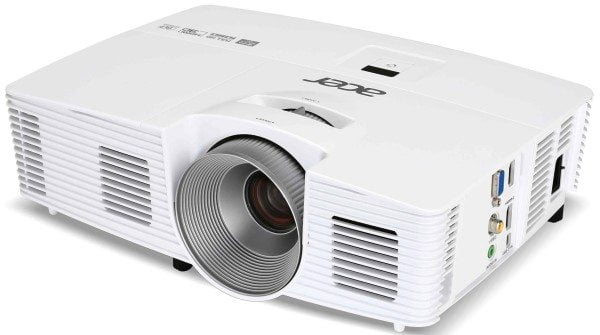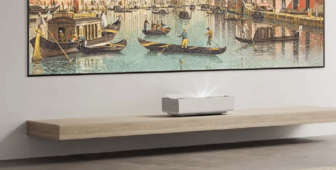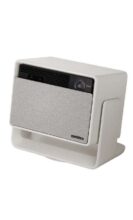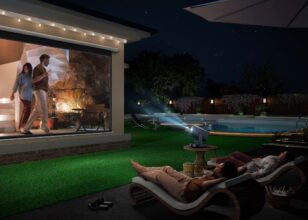Acer H6520BD Review
The H6510BD has a 1.3x lens and a minimum projection distance of 1.5m, while the H6520BD tested here has a 1.1x lens and a projection distance of 1m or more. A wireless facility is claimed, via an optional HDMI dongle, for the H6520BD. However, this can be added to the H6510BD, too. Infuriatingly, the H6520BD lacks the other model’s integrated control panel. As a result, the handset is essential for operation under most circumstances. Furthermore, the PDF manual covers over 50 models. This is asking for trouble, especially among newcomers.
It might be a budget model, but the quiet-running H6520BD delivers the home cinema essentials. Its inputs are sensibly side-mounted for ease of access. They include two HDMI 1.4a ports (one with MHL for mobile devices) and VGA (analogue RGBHV). A USB port, rather than the industry-standard RS232, is provided for installers and professional use. For uncritical applications, there’s an on-board audio system that sounds thin and gutless.That 1,920 x 1,080 resolution (with 24p refresh-rate support) is achieved using a single 0.65in 16:9 DLP chip and a six-segment colour wheel. Acer claims a 10,000:1 contrast ratio and 3,500 Lumens brightness. The 3D capability is Active Shutter but, perhaps understandably, no glasses are supplied. Thankfully, the DLP-Link protocol is employed here and so many compatible goggles are available to you.

Zoom and focus are manual operations, with the controls found on the lens barrel itself. Adjustment is easy, and I found settings are held over time – despite the projector’s tendency to get rather warm in use. A series of adjustable feet help you align the image to your screen if the projector is placed on a table. There is no lens shift provided. The onboard scaler will provide vertical keystone correction if you cannot avoid it.
To give you a rough idea of what can be achieved with this bargain beamer, a 3.3m projection distance will throw an image of approximately 100in measured diagonally – double that for a 200in picture. Depending on the screen you’re using, the picture might ‘spill over’ the screen’s edges in smaller rooms – even with minimal zoom. This was certainly true in one of my situations (throw distance just over 3m, 85in effective screen area).
With no signal, basic setup functions and a test pattern are available in Menu mode. With a source applied, though, the full gamut of adjustments is offered. One of the setup options in the menus compensates for wall color; Acer understands not everyone will be employing a dedicated screen.
More important tweaks include color temperature, gamma, Dynamic Black, Eco lamp mode and 3D settings. You can even grab an image from an incoming source and use it as a startup screen. There are six picture presets – change any of their adjustments, and it becomes the User setting. Sadly, only one of these is provided.
To Acer’s credit, little further adjustment was required to optimize the Movie preset. Domestic-sized pictures (say, 100in) are, however, exceptionally bright. The Eco mode tames this slightly, with the additional benefit of increasing lamp life. Disabling the ‘BrilliantColor’ feature was found to help, too. Naturally, blacks are moderately enhanced through such measures.
Even then, the H6520BD won’t deliver the deepest blacks you’ll ever see – but your eyes soon accommodate the very dark grey that is the best the PJ can muster. Much of the problem here is that even in Eco mode, the picture is still very bright, to the extent that the image is perfectly watchable in day-lit rooms.For all this, the H6520BD does a good job when it comes to depth and contrast range. In Chapter 20 of enjoyable spy caper Kingsman: The Secret Service, the loyalty of newbie agent Eggsy is tested by him being tied to the tracks of an underground line. Detail is visible in the dark areas of the tube tunnel and between the sleepers, while the lights of the approaching train and the surrounding murkiness are kept in balance.
Another key aspect of video performance isn’t forgotten. The random ‘handheld’ look of The Hurt Locker’s opening chapter fails to confuse the H6520BD’s processing – pictures are unspoilt by motion judder, and smooth movement (of passing vehicles and the bomb-disposal robot, for example) is preserved. The yellow tints and parched scenery carry well, and flesh tones are credible. With lesser material, such as standard-def TV, caption judder occurs very occasionally – and sometimes color-lag is noticeable.
Less subtle colors are reproduced excellently – the blood and fire that is seen throughout much of The Hurt Locker, and the explosions of color that follow Merlin’s activation of explosive devices in Kingsman… are vividly rendered. However, other less welcome colors can spoil the fun. I’m talking about the rainbow effect, fl ashes of color to which some viewers are more sensitive than others, especially during bright scenes. To be fair, it’s not as bad here as on some past PJs, but it could have been banished with LED lighting or faster-spinning color wheels.
3D material works well. In the Johnny Depp sci-fi yarn Transcendence, the effect is especially palpable with the overhead views of the Brightwood complex, the desert solar-arrays that provide its energy and the nanobot swarms that repair it.
Acer’s H6520BD can be considered a solid budget buy. Sure, there are some cons (regarding setup flexibility in particular) but these are balanced by its mostly satisfying pictures. Don’t expect miracles at this price point and you’ll be fine.
Specs
4K: No. 1,920 x 1,080 (Full HD)CONNECTIONS: 2 x HDMI; composite; component; VGA (15-pin D-sub); 3.5mm audio in (audio from HDMI supported, too); USB (control)BRIGHTNESS (CLAIMED): 3,500 LumensDIMENSIONS: 314(w) x 93(h) x 223(d)mm
FEATURES: 0.65in/1,920 x 1,080 DMD imaging device; 2x six-segment colour wheel; verticalkeystone correction; ‘wall colour’ compensation; DLP Link for (optional) 3D glasses; projected image 28in-300in (diagonal); projection distance 1m-9.8m; throw-ratio 1.48 to 1.62:1; grab image from video for startup screen; 1.1x zoom lens; one HDMI port MHL-compliant for mobile devices; built-in 2W speaker; 5,000-hour lamp life in Eco mode; BrilliantColor; Dynamic Black; 27dB running noise in Eco mode






